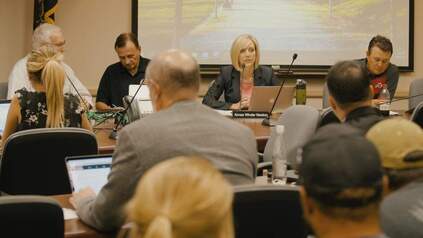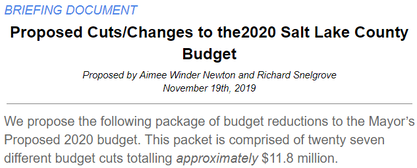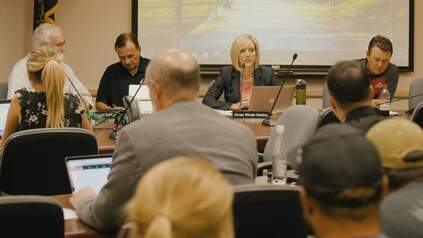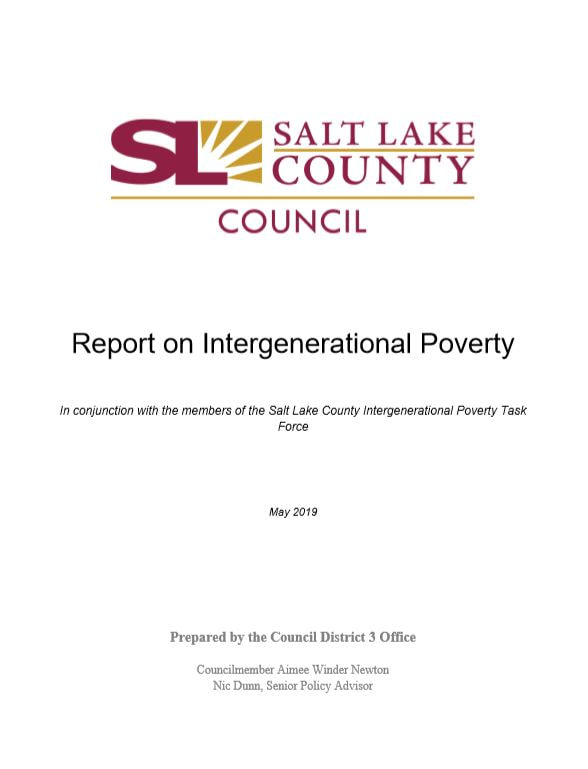|
"I want to die. I’m done.” Those were the words I heard from one of my children several years ago. It was late one evening, my husband was out of town, and when my son came to me for help, my brain was reeling… I didn’t know what to do.
I’m not alone when it comes to having children, a spouse, or other family members with mental health challenges. As I’ve worked on these issues as a Salt Lake County Councilmember, and on the state’s mental health crisis response commission, I know we need to talk openly and break the stigma. I’m grateful to my family members who have given me permission to share some of our experiences… A few of my kids have struggled with anxiety — it runs in my family. In fact, I can relate with how they feel because I, too, have battled it. After years of putting myself in high-anxiety situations, meeting with a helpful therapist, and learning my triggers (lack of sleep is the biggest one), I’ve been able to mostly overcome it. But my kids have had to learn in their own ways what their anxiety triggers are, and what they are willing to do to overcome it. I’ve had some kids who gladly met with a therapist, and others who thought they “didn’t need that,” and later realized that therapy is immensely helpful. I’ve had some of my kids who have tried medication and decided it didn’t help them much, and others who are grateful for modern medicinal miracles. All have realized that solving mental health issues is more than taking a pill. It’s work. Physical, mental, emotional and spiritual health are intertwined. I’ve experienced depression as both the patient and the spouse. After my second baby was born, I found myself dealing with post partum depression and it was awful. Feeling like you have nothing to look forward to, and even wondering if your presence on this earth is meaningful is not a pleasant experience, but I gained empathy for those who deal with it. My husband went through a bout of depression a few years after we were married. I think that being the spouse of someone dealing with depression is far worse than actually being depressed myself. It was the most helpless feeling I had ever felt. I wanted to fix things for him, make him all better, and watching him suffer was difficult to watch. We were lucky it was a short-term issue. So back to the son at the beginning of this article… I took him to the hospital. And later found out that some hospitals are better for suicidality than others. I learned how hard it is to be the parent of a loved one who was suicidal. Every day I would worry if he slept in too long, or if he didn’t come home on time. I had nightmares about finding him dead. It was such a scary time and I’m so grateful he got the help he needed and is doing so well now! During that time I also found out about an awesome resource that Salt Lake County helps to fund — the UNI Crisis Line. You can call 801-587-3000 anytime to speak with a professional. My advice to all of you who are struggling or are watching a family member struggle… talk to someone. Don’t suffer in silence. This illness totally sucks for so many reasons. My heart aches for those of you in the throes of this, but hang in there. It can be overcome and the sun will come out tomorrow.
0 Comments
I have always loved the Fourth of July. Our family activities over the years have ranged from driving up the canyon to the Brighton Breakfast or riding parades. In the evening, we’ve had the tradition of lighting fireworks with our neighbors. I love to celebrate America and appreciate the incredible and miraculous history of our country. This year our family enjoyed watching, “Hamilton” and gained an even greater appreciation for our Founding Fathers.
As I reflected on our celebration of America, I’ve thought a lot about the creation of our country, as well as the issues facing our country today. I have no doubt that the events that transpired during the Revolutionary War, the incredible feat of developing our country’s Constitution, and many other events during this time were truly miracles. So let’s talk about modern times. This year was interesting. Besides a pandemic, earthquake, and fires, we have civil unrest that has escalated in our own cities. Without getting into details of these highly emotional and often politicized specifics, I think it’s safe to say that most of us have seen the incredible divide in our society. No longer can we share a political viewpoint without others going on the attack. Social media has become a civil war of sorts where people seem to have lost all civility and respect for their fellow humans. This Fourth of July was interesting for me. As an elected official, I wanted to post something on my public Facebook page to honor the day, but I even found myself scratching my head… not sure how to post something that wouldn’t create drama, or could be politicized. I’m finding more and more that posting about puppies seems to be the only safe play on social media. I am grateful for our country. I know that America is an incredible place and we all have much to be grateful for. But right now some have their anxiety on high alert as we continually see news reports of riots, Covid cases on the rise, racial divide, earthquakes, and other crazy 2020 issues. So how do we find peace in 2020? When I was decorating my family room a few years ago I ran into an awesome sale at Bed, Bath and Beyond. I found a giant wood wall hanging with colors that matched perfectly for only $19.99 and I bought it. The words were nice. But never before have these words been needed more than this year. It says, “Peace is not about silence. It is not a place without trouble or fear. Peace is standing in the middle of chaos and finding the calm in your heart.” Whether upset by destruction during downtown riots, a crazy busy governor’s race, or other family issues, I’ve needed to remember where peace really comes from and how to find that calm in my heart. In the past I’ve struggled with anxiety - an ailment that seems to run in my family. Being able to look at things with a pragmatic viewpoint, relying on my faith to help me through, and getting enough sleep at night are some of the things I’ve learned to do to help me have that calm in my heart. It’s not easy, and there are many things that are out of our control, but relying on my higher power, keeping my friend and family relationships strong, and taking care of myself are things that seem to help. As we continue through this crazy year, my best wishes to you and your family to find that calm in your heart. The worldwide pandemic and resulting quarantine has highlighted many of the areas in society where we can improve. Since mid-March, calls to domestic violence hotlines, the suicide hotline, and substance abuse hotlines have increased. Now more than ever we need access to good behavioral health services.
Oftentimes we see law enforcement on the front lines of these battles. When an officer picks up someone who is in need of behavioral health services, they take them to the emergency room or the jail. Neither one is the best place for someone to get long-term mental health care or substance abuse help, and they are both expensive options. Salt Lake County has been on the leading edge of this work. As we’ve explored best practices in other states, we recognize that a receiving center dedicated to behavioral health is the least expensive and gives the best outcomes for our residents. Last year I had the opportunity to travel to Arizona as a member of the state’s mental health crisis commission. We toured their receiving center and saw their comprehensive crisis services. Our commission and Salt Lake County supported a legislative appropriation to fund a receiving center pilot project in areas throughout the state. It passed! Salt Lake County stepped up to also partner with resources, and we are hoping to move forward with a receiving center in the near future, as long as the funds remain after the upcoming legislative budget cuts. (So tell your legislator to keep HB 32 funded!) In Salt Lake County we already have an incredible crisis line to take calls and texts 24/7, that number is 801-587-3000. We also pay to dispatch a Mobile Crisis Outreach Team (MCOT) to those who are in crisis, recognizing law enforcement can’t be expected to be all things to all people. But we have a gap in treatment services. A receiving center will offer medical and psychiatric triage, clinical assessment, peer support, discharge planning, connection to community resources, and referral services to treatment programs including in-patient care, medical care, and detox. Having a receiving center is a more cost-effective way to treat patients and takes the pressure off of emergency rooms and jails - which are currently the only options. It will create savings across the county in hospitals, law enforcement agencies, the county jail, and the court system. It will also save the state money as receiving center Medicaid bills will be less expensive than an emergency room visit. Behavioral health is a top priority and I’m hopeful we will see some meaningful improvements to the existing system which will give real help to those suffering, save tax dollars in the long run, and lighten the burden in jails, emergency rooms, and with law enforcement. As we celebrate Memorial Day this month, I would like to give my thanks to those who serve in the military and their families, as well as condolences to those who have lost loved ones in service. It’s a beautiful time to honor them and the ultimate sacrifice that they have made.
I often think of my friend, Jennie Taylor, who is now a widow. Her husband, North Ogden Mayor Brent Taylor, was a major in the US Army National Guard. He answered the call to serve his country in Afghanistan where he was killed, leaving Jennie and their seven children behind. Brent was a friend of mine through our public service experiences. Just before he was killed, he posted on Facebook about the people in Afghanistan being able to vote. He showed a photo of a long line of people waiting to do so. What a profound reminder of the liberties and freedoms we have been given here in the United States and why we have amazing people like Brent to help protect us and those freedoms. For those of you who are grieving as you remember your loved ones. I have a small understanding of the loss and grief that comes from saying goodbye. On Sept 11, 2011, my husband and I were hustling our kids to bed when I heard a knock at my front door. I opened the door to see my brother, Mike, and his wife, Karyn, standing on my porch. They came in the house and Mike told me how mom and dad were driving down to St George, there was a bad storm and they were in a car accident, “Mom is dead and dad is in the hospital,” he muttered. I cried out, “But I still need a mom.” After visiting each of our siblings to deliver the news, and making the terrible call to tell my mom’s mother that her oldest daughter had passed, Mike and I drove down to St George to be with our dad. Wow – it was like I was punched in the gut. My mom was 57 years old and in great health. She had 11 grandchildren. It was a difficult first few years and I still think of her and miss her all the time. Three years after losing mom, my youngest brother, Isaac, and his wife and two year old daughter decided to move to China to teach English and have an adventure. Isaac got food poisoning and because of the medication he was taking, combined with the dehydration, he landed in the hospital and eventually went into a coma. In this Chinese hospital, family members only could visit their loved one and speak to healthcare providers during one 30 minute time period each day. It was grueling for Isaac’s wife, Candalyn. My dad and Chinese-speaking brother were able to secure emergency visas to go over and assist. While there they got word that Isaac would never fully recover and would be brain dead. The family made the difficult decision to let him go. Losing two of my six original family members has been hard. We miss mom and Isaac desperately. But there are interesting blessings that come from hard situations. We now have a bonus mom (that’s what we call our stepmom) and her two wonderful sons and their families who have joined our Winder family. Several years after Isaac’s death, his wife Candalyn was able to earn her masters degree and found a wonderful man to marry, Jason, who we’ve also welcomed into our family. They even had a new baby a few weeks ago. Our family gets together for an adult date night and family dinner with all the kids once per month. We sometimes can’t explain how we are all related in simple terms, but we love each other and provide support for each other. We all know loss and we find ways to help each other. Though some days are hard, and we desperately miss the loved ones who have passed, we find ways to see the rainbows and silver linings of life. As a Salt Lake County Council member, I often see people who have difficulties in their life – health challenges, poverty, childhood trauma, mental health, homelessness and heartache. It’s hard to see so much sadness. Sometimes life doesn’t seem fair. I also get a chance to see the wonderful people in this community who serve others. People reaching out, often to complete strangers, to lighten their load, people who give of themselves so unselfishly. It is heartwarming to know there are so many good people out there. Thank you for all of you who serve and help your fellowmen. As I’ve mourned the loss of loved ones, and some days have been buried with overwhelming grief, I’ve found reprieve by looking outside myself and finding ways to serve. As Mahatma Gandhi said, “The best way to find yourself is to lose yourself in the service of others.” As we celebrate Memorial Day, I am grateful for our military men and women who serve so that we have the incredible freedoms that we do. I’m also grateful for my family members who have passed on. May you have sweet experiences as you remember your loved ones and cherish happy memories. At the time I submitted this article, we were all at home, trying to steer clear of other humans to avoid COVID-19. Who knows what the next two weeks will bring as our state, nation and world deal with this crazy virus? And to make matters even more interesting… we had an earthquake.
I spent some time at our Salt Lake County Emergency Operations Center. Rest assured we have professionals helping us navigate these difficult situations. Our county health director has been involved in every detail related to COVID-19. Our public safety and public works personnel oversaw issues related to the earthquake. We have others who are monitoring public safety and health 24/7 and keeping policy-makers and other decision-makers informed. These people are watching out for you. It’s times like these that I think about how lucky we are to have strong communities that band together and help each other during times of need. It’s touching to see neighbors reaching out to each other to make sure they are okay. I love hearing stories of how families are trying to still support local businesses during these difficult times. There is a lot of uncertainty right now. This text from my neighbor was poignant, and I share this with his permission so we can all better understand some of the additional burdens small business owners may be carrying. Others may have these same fears as they wonder if they will be getting a paycheck, or if their job will exist: “Of course we all want to be civil minded and help keep the virus from spreading, but at what economic cost? We all have families to feed. My business is responsible for the income of six families. If I go under, a lot of people will become welfare burdens on the state. I believe It is very shortsighted for the government to mandate so much of small businesses without giving any definitive help. They want to force us to give employees paid time off. That mandate alone will bankrupt me. Promises of small business loans and a website address aren’t going to cut it.” I get it. It’s frustrating when we have no timelines and not a lot of great answers. The great thing about Utah, though, is we know how to do hard things and this will not last forever - aftershocks will stop, immunity will develop, supply chains and economies will adapt, and markets will recover. Jobs will once again be plentiful and businesses will boom. We can do this! In the meantime, hug your families (or maybe elbow-bump), keep an eye out for your neighbors, and stay healthy.  Utah women were the first in the nation to vote 150 years ago. A young, 23-year-old school teacher, Seraph Young, cast her ballot on her way to work on the morning of February 14, 1870 and became the very first woman, under an equal suffrage law, to vote. This year we’re celebrating Utah’s leadership in the nation on this very important issue. Utah’s suffrage history is a story of cooperation and civic engagement. It’s the story of Utah men and women working together in a common cause for the benefit of all. On a cold January day in 1870, 5,000 women gathered in downtown Salt Lake City to ask for, among other things, the right to vote. Just a few weeks later the territorial Utah Legislature, made up entirely of men, unanimously extended that right. For the next 17 years they voted side by side trying to craft their territory into a place where they could live according to their ideals. But, in 1887, in an attempt to end polygamy, Congress passed the Edmunds-Tucker Act, which took away from all Utah women the right to vote. Needless to say they were outraged and went to work immediately trying to win it back. They knew that it was important to have a say in their communities and that one of the most effective ways to do that was to vote. They created the Woman Suffrage Association of Utah and organized local chapters throughout the territory. Utah women met together, and organized. They signed petitions, and they spoke up for what they believed in. When Utah held it’s Constitutional Convention in 1895, both parties supported voting rights for women in their platforms. The delegates included a clause in the Utah Constitution that read, “The rights of citizens of the State of Utah to vote and hold office shall not be denied on account of sex. Both male and female citizens of this State shall enjoy equally all civil, political and religious rights and privileges.” Once again the all-male electorate overwhelmingly approved sharing the franchise with their wives, sisters, and mothers. The story didn’t end there. After winning the right to vote for themselves, Utah women went to work on behalf of their sisters across the United States. They testified before Congress, raised money, worked with the national suffrage organizations, and some of them were even arrested and beaten as they tried to make sure that women across the nation enjoyed the same rights that they held. In August 1920, the 19th Amendment was ratified granting suffrage to women across the United States. The cooperation and civic engagement continued after the 19th Amendment passed to ensure that minority groups could equally enjoy that privilege. Utah has a strong history of leadership and a legacy of influential women and men working together who understood that Utah, and the nation, prospers when each citizen has the opportunity to participate. How can we live up to that legacy? As we enter an election year I challenge you to make sure you are registered to vote and then exercise that right! Visit vote.utah.gov to register, or check your information. We stand on the shoulders of men and women who understood how much voting matters and that they could make a difference in their communities by participating. Let’s live up to this incredible legacy. To learn more about Utah’s suffrage history or to see how your city can celebrate the suffrage anniversaries this year please visit UtahHERitage.org.  Aimee speaking during a County Council meeting Aimee speaking during a County Council meeting One of the most important parts of being an elected official is acting as a steward of taxpayer dollars. Residents entrust those who run the government to judiciously use their tax dollars to perform essential functions for the community, and as such residents expect that every dollar spent by the government will be carefully scrutinized. That’s why I take my role on the County Council so seriously, especially when it comes to budget season. Each fall the Mayor presents a proposed Salt Lake County budget to the Council, and in the subsequent weeks Council members have the opportunity to review all the new budgetary requests as well as any and all ongoing expenditures. As listened to constituents, and worked with some of my colleagues and Council staff to comb through the budget, I felt an added urgency to find efficiencies given the fact that the Mayor’s budget included a nearly $18 million dollar property tax increase. First, I have to give a shout out to the staff in the Mayor’s administration. The fiscal managers, program directors, and many more were extremely helpful and professional throughout this process. I’m always impressed by their work ethic and professionalism, even when being asked many tough budgetary questions.  CLICK THUMBNAIL FOR LIST CLICK THUMBNAIL FOR LIST Ultimately, my colleague Council Chair Richard Snelgrove and I proposed a package of roughly $11.8 million in proposed cuts to the budget. The Council ended up approving about $6 million in cuts. I’m pleased there were some non-essential items removed, but also disappointed we didn’t cut more. I’ve included here the full list of cuts/proposals that I spoke to in our council meeting last Tuesday. Some of these items are rough dollar amounts based on multiple factors, or would need to be implemented thoughtfully, but each proposal is intended to curb expenditures in an area that may be nice to have, but is not essential to the core role of county government (especially in a tax increase year). The reason I am so passionate about cutting the “nice to have” items from government is simply this: it isn’t our money—it belongs to the taxpayers. Every trim we can make to push back against the natural tendency of government to grow can help keep more of your tax dollars in your own wallets. And I always believe we can do this while still making valuable investments in public services, which I’ve defended before. But our aim should always be to achieve maximum efficiency, and keep the role of government restrained and carefully targeted.
Going through the largest government budget in Utah (second only to the state government budget itself) that totals roughly $1.4 billion is hard work, but I love the opportunity to do so on behalf of my constituents. Every vote I cast as a County Council member comes after thoughtful consideration of how it will impact the county, our residents, and the constituents whom I represent in this role. Every fall, Salt Lake County goes through its annual budget process. As the government entity with the second largest government budget in Utah (coming behind only the state budget itself), there are a myriad of programs, services, and expenditures that comprise the now $1.4 billion budget. In addition to the statutorily required functions that include assessing and collecting taxes, running elections, and core criminal justice/public safety roles, there are quality of life functions that make Salt Lake County a better place for families to flourish. These include our regional parks, recreation centers, open space, libraries, and other regionally significant amenities - some of which are funded through tourism dollars. I love living in Salt Lake County, both for the quality of life as well as the fact that we work hard to tackle tough challenges like childhood trauma, poverty, affordable housing, and more. It’s very important to me that county government performs its essential and important functions with integrity, transparency, and efficiency.  The budget season is a time when I and my colleagues on the council must act in an oversight role over the executive branch to ensure funds are spent in accordance with the principles above. This is particularly important this year, given that the County Mayor’s proposed budget includes a nearly $18 million property tax increase. My goal is to find any unnecessary spending so that we can balance the budget without a tax increase, before we ever ask taxpayers for more. A year and a half ago, I asked a group of community leaders, experts, and advocates to come together to form Salt Lake County's first ever task force addressing intergenerational poverty. We recently produced a comprehensive report that outlines our work, as well as providing some important policy recommendations. You can read the full report below.
I am working to ensure:
Strong Communities by supporting more recreational space for families, working to prevent child abuse, increasing mental health resources to prevent teen suicide, and tackling the issue of intergenerational poverty. Facing these important issues will help improve the quality of life throughout our community. Fiscal Discipline by being a budget hawk, with eyes on preserving Salt Lake County's AAA credit rating and implementing prudent spending practices to protect your tax dollars. Public Safety by advocating for additional jail beds to enable police to do their job, while providing substance abuse and mental health programming so that those incarcerated don't become repeat offenders. A safe community is my top priority. Government Accountability
Healthy Living
Strong Economy
"Accountability, transparency, and accessibility are vital in government. I will do all I can to support the highest quality service at the lowest possible price." Aimee has been serving on the county council since January 2014, and is the first women elected as chair of the council. Here are some of the things she has done:
“Aimee is REAL. She is down-to-earth, accessible and authentic. She brings common sense and collaboration to the council.” – Salt Lake County Councilmember Richard Snelgrove |
Aimee Winder NewtonAimee Winder Newton has served since 2014 and represents Taylorsville, Murray, West Jordan, and West Valley City on the Salt Lake County Council. She was a former 2020 Republican candidate for Utah Governor and was the first woman elected as chair of the Council. Aimee works tirelessly to defend the quality of life in Salt Lake County while protecting tax dollars... [read more]
Categories
All
|
||||||
| Aimee Winder Newton | aimee winder newton: County Council district 3 |


